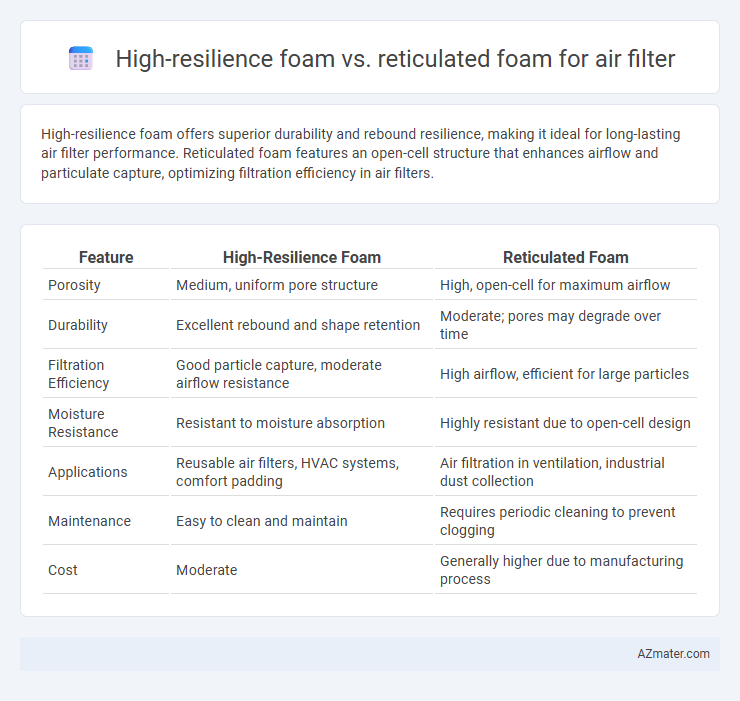High-resilience foam offers superior durability and rebound resilience, making it ideal for long-lasting air filter performance. Reticulated foam features an open-cell structure that enhances airflow and particulate capture, optimizing filtration efficiency in air filters.
Table of Comparison
| Feature | High-Resilience Foam | Reticulated Foam |
|---|---|---|
| Porosity | Medium, uniform pore structure | High, open-cell for maximum airflow |
| Durability | Excellent rebound and shape retention | Moderate; pores may degrade over time |
| Filtration Efficiency | Good particle capture, moderate airflow resistance | High airflow, efficient for large particles |
| Moisture Resistance | Resistant to moisture absorption | Highly resistant due to open-cell design |
| Applications | Reusable air filters, HVAC systems, comfort padding | Air filtration in ventilation, industrial dust collection |
| Maintenance | Easy to clean and maintain | Requires periodic cleaning to prevent clogging |
| Cost | Moderate | Generally higher due to manufacturing process |
Introduction to Air Filter Foams
High-resilience foam offers superior elasticity and durability, making it ideal for air filters that require consistent airflow and long-term performance. Reticulated foam features an open-cell structure that enhances air permeability and particle capture efficiency, optimizing filtration in HVAC systems and automotive applications. Selecting the appropriate foam depends on balancing filtration efficiency, airflow resistance, and environmental conditions specific to the air filter's operational context.
What Is High-Resilience Foam?
High-resilience foam, known for its durability and elasticity, is widely used in air filters for efficient particle capture and airflow maintenance. This type of foam features high cell density and open-cell structure, allowing superior air permeability while trapping dust and contaminants effectively. Compared to reticulated foam, high-resilience foam provides enhanced support and longer lifespan in demanding filtration applications.
What Is Reticulated Foam?
Reticulated foam is a highly porous, open-cell material created by removing the cell membranes from polyurethane foam, enabling superior air and liquid flow. This structure allows reticulated foam to capture airborne particles effectively while maintaining low resistance, making it ideal for air filtration applications. Compared to high-resilience foam, which is denser and less permeable, reticulated foam provides enhanced airflow and improved filtration efficiency in HVAC systems and industrial air filters.
Pore Structure and Airflow Efficiency
High-resilience foam features closed-cell structures with consistent pore distribution, providing strong resistance to deformation and moderate airflow efficiency in air filters. Reticulated foam has an open-cell, highly porous network that maximizes airflow permeability while effectively capturing airborne particles, enhancing filtration performance. The pore structure in reticulated foam enables superior air passage and contaminant retention compared to the denser, less permeable high-resilience foam.
Filtration Performance Comparison
High-resilience foam offers excellent filtration performance with its dense, open-cell structure, effectively capturing larger particles and providing durability for repeated use in air filters. Reticulated foam's highly porous, skeletal framework excels at trapping smaller airborne contaminants and enables superior airflow, resulting in enhanced filtration efficiency for fine particulates. Comparing the two, reticulated foam generally provides higher filtration precision and airflow rates, while high-resilience foam balances particle capture with long-term mechanical resilience.
Durability and Longevity
High-resilience foam exhibits superior durability due to its dense cellular structure that resists compression over time, making it ideal for long-term air filter applications. Reticulated foam offers enhanced airflow because of its open-cell design but typically has reduced longevity as the thin cell walls deteriorate faster under continuous stress. When prioritizing filter lifespan and structural integrity, high-resilience foam consistently outperforms reticulated foam in maintaining filtration efficiency and mechanical stability.
Maintenance Requirements
High-resilience foam air filters require less frequent cleaning due to their dense structure, which traps larger particles effectively while maintaining airflow. Reticulated foam filters need more regular maintenance because their open-cell design captures finer particles but is prone to clogging faster. Proper and timely cleaning of both foam types prolongs filter life and ensures optimal air quality and system performance.
Cost Considerations
High-resilience foam air filters generally offer a lower upfront cost compared to reticulated foam due to simpler manufacturing processes and readily available materials. Reticulated foam, characterized by its open-cell structure and superior filtration efficiency, incurs higher production expenses that translate to increased market prices. Evaluating cost involves balancing initial investment with durability and performance, as reticulated foam filters often last longer and provide enhanced airflow, potentially reducing operational expenses over time.
Best Applications for Each Foam Type
High-resilience foam is ideal for HVAC air filters and automotive cabin filters due to its excellent durability and ability to retain shape under pressure, providing long-lasting filtration and consistent airflow. Reticulated foam, characterized by its open-cell structure and high porosity, excels in applications requiring maximum airflow and efficient particle capture, such as in industrial air purification and swimming pool filtration systems. Selecting the appropriate foam depends on balancing airflow resistance, filtration efficiency, and environmental conditions specific to each application.
Choosing the Right Foam for Air Filters
High-resilience foam offers excellent durability and maintains consistent airflow, making it ideal for air filters requiring long-term use and high filtration efficiency. Reticulated foam features an open-cell structure that enhances air permeability while effectively trapping particulate matter, suited for applications demanding superior filtration with minimal air resistance. Selecting the right foam depends on balancing factors such as airflow requirements, filtration efficiency, durability, and specific environmental conditions.

Infographic: High-resilience foam vs Reticulated foam for Air filter
 azmater.com
azmater.com